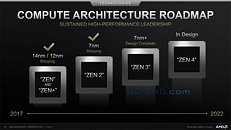Thursday, September 12th 2019

AMD Updates Roadmaps to Lock RDNA2 and Zen 3 onto 7nm+, with 2020 Launch Window
AMD updated its technology roadmaps to reflect a 2020 launch window for its upcoming CPU and graphics architectures, "Zen 3" and RDNA2. The two will be based on 7 nm+ , which is AMD-speak for the 7 nanometer EUV silicon fabrication process at TSMC, that promises a significant 20 percent increase in transistor-densities, giving AMD high transistor budgets and more clock-speed headroom. The roadmap slides however hint that unlike the "Zen 2" and RDNA simultaneous launch on 7th July 2019, the next-generation launches may not be simultaneous.
The slide for CPU microarchitecture states that the design phase of "Zen 3" is complete, and that the microarchitecture team has already moved on to develop "Zen 4." This means AMD is now developing products that implement "Zen 3." On the other hand, RDNA2 is still in design phase. The crude x-axis on both slides that denotes year of expected shipping, too appears to suggest that "Zen 3" based products will precede RDNA2 based ones. "Zen 3" will be AMD's first response to Intel's "Comet Lake-S" or even "Ice Lake-S," if the latter comes to fruition before Computex 2020. In the run up to RDNA2, AMD will scale up RDNA a notch larger with the "Navi 12" silicon to compete with graphics cards based on NVIDIA's "TU104" silicon. "Zen 2" will receive product stack additions in the form of a new 16-core Ryzen 9-series chip later this month, and the 3rd generation Ryzen Threadripper family.
Source:
Guru3D
The slide for CPU microarchitecture states that the design phase of "Zen 3" is complete, and that the microarchitecture team has already moved on to develop "Zen 4." This means AMD is now developing products that implement "Zen 3." On the other hand, RDNA2 is still in design phase. The crude x-axis on both slides that denotes year of expected shipping, too appears to suggest that "Zen 3" based products will precede RDNA2 based ones. "Zen 3" will be AMD's first response to Intel's "Comet Lake-S" or even "Ice Lake-S," if the latter comes to fruition before Computex 2020. In the run up to RDNA2, AMD will scale up RDNA a notch larger with the "Navi 12" silicon to compete with graphics cards based on NVIDIA's "TU104" silicon. "Zen 2" will receive product stack additions in the form of a new 16-core Ryzen 9-series chip later this month, and the 3rd generation Ryzen Threadripper family.


103 Comments on AMD Updates Roadmaps to Lock RDNA2 and Zen 3 onto 7nm+, with 2020 Launch Window
Yeah, AMD bad at driver , but how many of them died within months ? :rolleyes:
Back then AMD had Athlon first (that brought the IPC fight to Intel). Then they had AthlonXP (dreamy overclocking). Then Athlon64 came (64bit and integrated memory controller). And then we had Athlon64 X2 (real multicore).
So they did have an engineering roadmap back then, too. They just left marketing and sales to chance.
Same goes here, I'm always had Crossfire since X850 XT master-slave era and have given me 0 issues. Are these sound plausible?
There always be a problem on both sides, whether you choose to hyperbolize minor glitch or you just pretend there's no elephant in the room. You know, like 95W TDP and 50Mhz lesser boost :rolleyes:
AMD need to catch up in the GPU market, and not by waiting and hoping for the competition to "screw up".Yes, AMD's driver quality is nowhere close to Nvidia's unfortunately. Whether or not this matters is up to the end users. But despite AMD having fewer resources than Nvidia, they could prioritize and get this solved. AMD have hundreds of engineers working on "optimizing" for games (which means manipulating shaders, etc.) to squeeze out that ~2% extra, while they should be focusing on making the best drivers ever. Even Nvidia's drivers is not perfect, so there is plenty of room for improvement.Due to the consoles, there are far more AMD sponsored titles.Feeding the conspiracy theories again?
A few cards being DoA, and a failure rate of 2-5% is completely normal, and Turing is below that. Most of the reported problems were later dismissed as driver bugs (which were also fixed), and only a few cards were actually defective.
And if you actually read my whole post, you would also see; Even Nvidia's drivers is not perfect, so there is plenty of room for improvement.
Turing launched with at least 3-4 bugs which were quickly fixed, which is a lot from Nvidia, and is probably the "worst driver launch" they've done in many years, and I've criticized it plenty for that reason. But at least their drivers are stable once the initial bugs are ironed out.
Back on topic: I don’t see how the clocks will improve. They barely got better with the shrink from 12 to 7 nm, and if they did, the all-core clocks are mostly about 100 MHz better - an improvement, yes, but not by much.
Anyhow, the crazy thing is that Nvidia is still the top dog with it's super old architecture.
Worth to watch.Article
RDNA 2 should improve at least 15%.
Save your time (and sanity) and only follow what they actually deliver. And this is not limited to AMD, I treat Nvidia and Intel just the same.